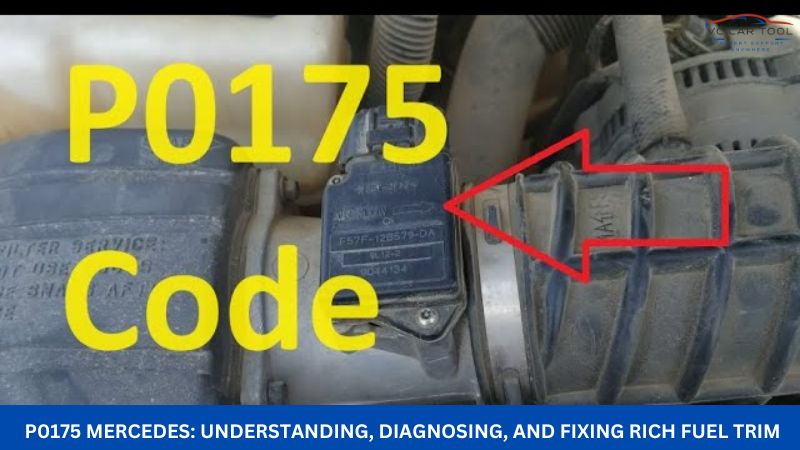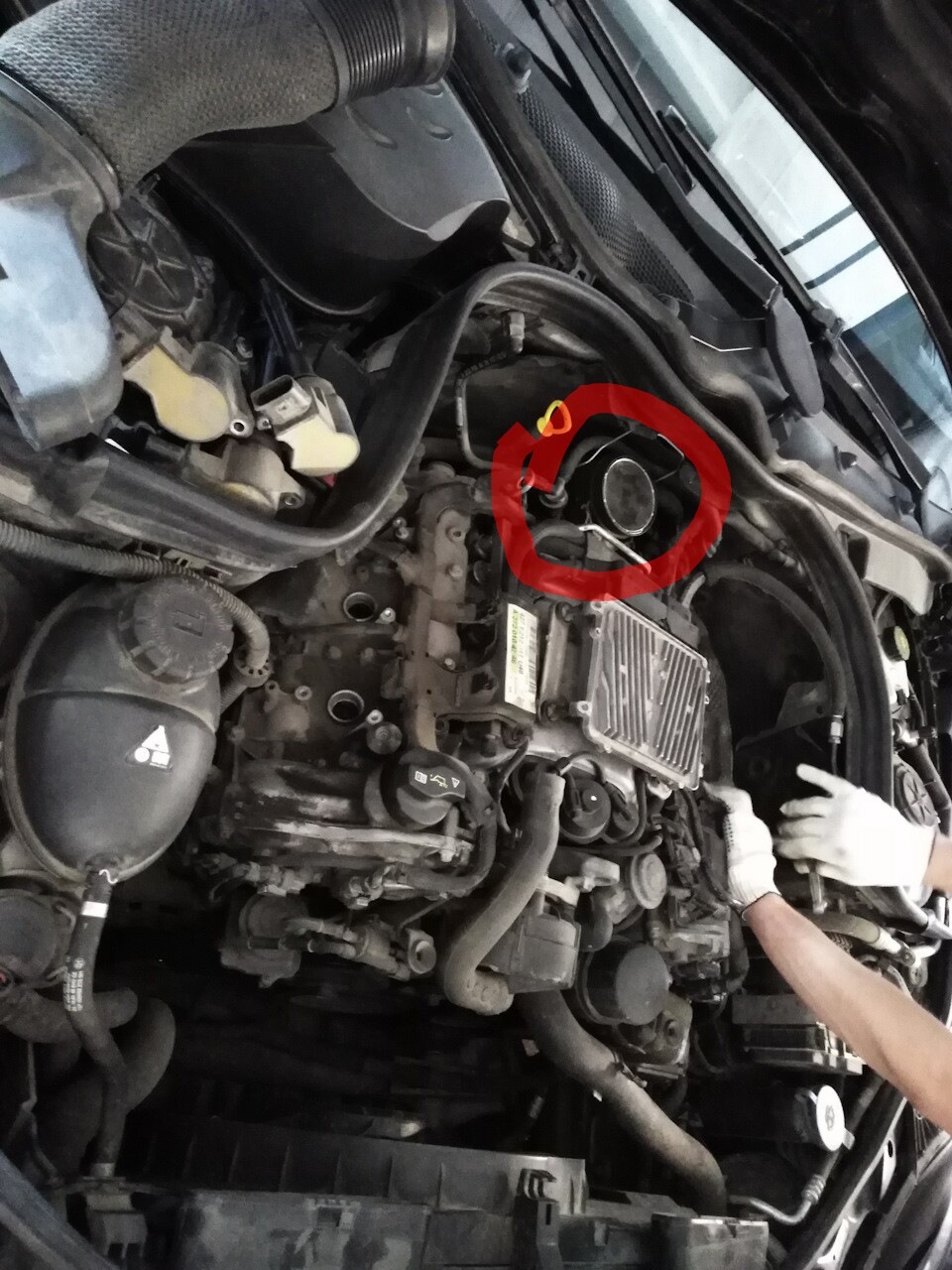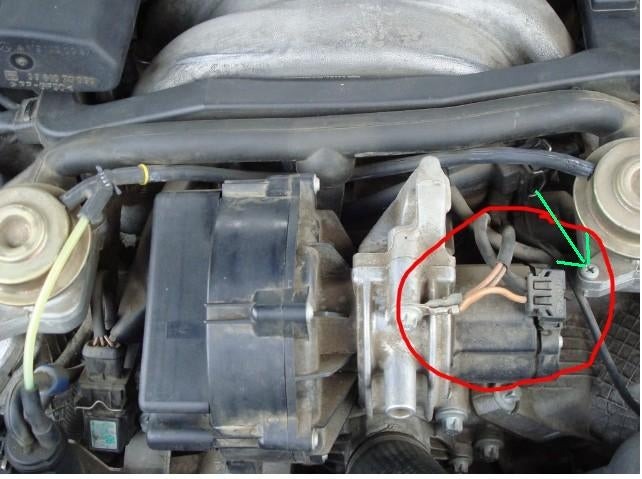P0175 Mercedes: Understanding, Diagnosing, and Fixing Rich Fuel Trim
Decoding the P0175 Mercedes trouble code means your engine’s running too rich on bank 2. Let’s explore potential causes and fixes, and why prompt action can save you from bigger headaches and costly repairs, plus how VCCarTool can help.
If you’re unsure about diagnosing or repairing the P0175 Mercedes code, contact VCCarTool via WhatsApp: +1 (901) 414 – 1927 for assistance to avoid further complications.

1. What Does the P0175 Mercedes Code Actually Mean?
The P0175 code on a Mercedes-Benz signals a “System Too Rich (Bank 2)” condition. This means the engine control unit (ECU) has detected an excess of fuel in the exhaust gases for engine bank 2. This excess fuel creates an imbalanced air-fuel ratio. Bank 2 refers to the side of the engine opposite cylinder number 1. According to the Environmental Protection Agency (EPA), maintaining the correct air-fuel ratio is crucial for optimal engine performance and minimizing emissions.

2. What are the Common Causes of a P0175 Mercedes Code?
Pinpointing the exact cause of a P0175 code can be tricky, but here’s a rundown of the usual suspects:
- Faulty Oxygen Sensor: A malfunctioning oxygen (O2) sensor on bank 2 might provide inaccurate readings, causing the ECU to incorrectly adjust the fuel mixture. According to a study by Bosch, faulty O2 sensors are a leading cause of fuel trim issues.
- Leaking Fuel Injector: A leaky injector on bank 2 can dump too much fuel into the cylinder, leading to a rich condition.
- Faulty Mass Air Flow (MAF) Sensor: An inaccurate MAF sensor can cause the ECU to miscalculate the amount of air entering the engine, leading to an incorrect fuel mixture.
- Fuel Pressure Regulator Issues: If the fuel pressure regulator is malfunctioning, it could cause excessive fuel pressure, forcing too much fuel into the engine.
- Vacuum Leaks: While less common for a “rich” code, a vacuum leak near bank 2 could disrupt the air-fuel mixture.
- Evaporative Emission (EVAP) System Problems: A malfunctioning EVAP system can sometimes cause a rich condition if it’s not venting properly.
- Engine Control Unit (ECU) Issues: Although rare, a faulty ECU could misinterpret sensor data and cause the P0175 code.
3. What are the Symptoms I Might Notice with a P0175 Code?
Besides the illuminated check engine light, you might experience these symptoms:
- Reduced Fuel Economy: Excess fuel consumption is a telltale sign.
- Poor Engine Performance: The engine might feel sluggish or hesitate during acceleration.
- Rough Idling: The engine might idle unevenly or stall.
- Black Smoke from Exhaust: This indicates excessive fuel burning.
- Fuel Smell: You might notice a distinct fuel odor, especially near the exhaust.
- Failed Emissions Test: A rich-running engine will likely fail an emissions test.

4. How Can I Diagnose the P0175 Mercedes Code?
Here’s a step-by-step approach to diagnosing the P0175 code:
- Read the Code: Use an OBD-II scanner to confirm the P0175 code and check for any other related codes.
- Inspect Oxygen Sensors: Check the O2 sensor readings on bank 2. Look for unusual or erratic behavior.
- Check Fuel Injectors: Inspect the fuel injectors on bank 2 for leaks or damage. A mechanic can perform a fuel injector balance test.
- Evaluate the MAF Sensor: Monitor the MAF sensor readings. Compare them to the manufacturer’s specifications.
- Test Fuel Pressure Regulator: Use a fuel pressure gauge to ensure the fuel pressure is within the correct range.
- Look for Vacuum Leaks: Inspect vacuum lines and intake manifold gaskets for leaks. Use a smoke machine to help locate hard-to-find leaks.
- Inspect the EVAP System: Check the EVAP system components, such as the purge valve and vent valve, for proper operation.
Having trouble with these steps? Contact VCCarTool via WhatsApp: +1 (901) 414 – 1927 for expert diagnostic assistance.
You may be interested in our Mercedes-specific diagnostic software and equipment: Mercedes Diagnostic Tool
5. Step-by-Step Guide to Fix P0175 Mercedes
Here’s a breakdown of potential fixes, ranging from simple to more complex:
- Address Obvious Issues: Fix any blatant problems like disconnected vacuum lines or damaged wiring.
- Replace Faulty Oxygen Sensor: If the O2 sensor on bank 2 is suspect, replace it with a new, high-quality sensor.
- Clean or Replace Fuel Injectors: If the fuel injectors are dirty, try cleaning them. If they’re leaking or damaged, replace them.
- Replace MAF Sensor: If the MAF sensor is providing inaccurate readings, replace it with a new sensor.
- Repair Fuel Pressure Regulator: If the fuel pressure regulator is faulty, replace it.
- Repair Vacuum Leaks: Repair any vacuum leaks you find.
- Address EVAP System Problems: Fix any issues with the EVAP system, such as a faulty purge valve or vent valve.
- Check Engine Control Unit (ECU): This is a last resort. Consult with a qualified mechanic to determine if the ECU is the problem.
6. Can I Fix P0175 Mercedes Myself, or Do I Need a Mechanic?
Some of the simpler fixes, like addressing vacuum leaks or replacing a faulty sensor, can be tackled by experienced DIYers. However, diagnosing the root cause and performing more complex repairs often requires specialized tools and expertise. If you’re not comfortable working on your car’s fuel system, it’s best to consult a qualified mechanic. VCCarTool offers remote diagnostic support to help you pinpoint the issue quickly and efficiently. Contact us via WhatsApp: +1 (901) 414 – 1927 for assistance.
7. What are the Risks of Ignoring the P0175 Mercedes Code?
Ignoring a P0175 code can lead to a range of problems:
- Catalytic Converter Damage: A rich-running engine can overheat and damage the catalytic converter, a costly repair. According to the Car Care Council, replacing a catalytic converter can cost upwards of $1,000.
- Increased Fuel Consumption: You’ll be wasting money on gas.
- Reduced Engine Life: Long-term rich running can cause carbon buildup and engine damage.
- Failed Emissions Tests: You won’t be able to register your vehicle if it fails an emissions test.
- Poor Performance: Your car will run sluggishly and may be unreliable.
8. How Much Does it Typically Cost to Fix a P0175 Mercedes Code?
The cost to fix a P0175 code varies depending on the cause:
- Oxygen Sensor Replacement: $200 – $400
- Fuel Injector Cleaning or Replacement: $150 – $800 (depending on the number of injectors)
- MAF Sensor Replacement: $150 – $300
- Fuel Pressure Regulator Replacement: $100 – $300
- Vacuum Leak Repair: $50 – $200
- Catalytic Converter Replacement: $800 – $2,000+
These are just estimates. Labor costs can vary depending on your location and the mechanic’s hourly rate.
9. How Can VCCarTool Help Me Resolve the P0175 Mercedes Code?
VCCarTool provides a suite of diagnostic and repair solutions to help you tackle the P0175 code:
- Remote Diagnostic Support: Our expert technicians can remotely diagnose your Mercedes using advanced diagnostic tools, pinpointing the exact cause of the code. Contact us via WhatsApp: +1 (901) 414 – 1927 for immediate assistance.
- Access to Repair Information: VCCarTool provides access to comprehensive repair manuals, wiring diagrams, and technical service bulletins (TSBs) specific to your Mercedes model.
- Software and Tools: We offer a range of professional-grade diagnostic software and tools to help you perform in-depth analysis and coding.
- Expert Advice: Our team of experienced mechanics is available to answer your questions and provide guidance throughout the repair process. Email us at [email protected].
10. Preventative Measures to Avoid the P0175 Mercedes Code
While you can’t completely eliminate the risk of a P0175 code, here are some preventative measures:
- Regular Maintenance: Follow your Mercedes’ recommended maintenance schedule, including oil changes, filter replacements, and spark plug replacements.
- Use Quality Fuel: Use high-quality fuel from reputable gas stations.
- Inspect Regularly: Periodically inspect your car’s engine components, such as vacuum lines and hoses, for signs of wear and tear.
- Address Issues Promptly: Don’t ignore minor engine problems. Address them promptly to prevent them from escalating.
11. Understanding Fuel Trims and the P0175 Code
Fuel trims are adjustments made by the ECU to maintain the optimal air-fuel ratio. Short-term fuel trim (STFT) reflects immediate adjustments, while long-term fuel trim (LTFT) represents learned adjustments over time. A positive fuel trim indicates the ECU is adding fuel (lean condition), while a negative fuel trim indicates the ECU is reducing fuel (rich condition). The P0175 code is triggered when the LTFT on bank 2 is excessively negative, indicating a persistent rich condition. According to SAE International, understanding fuel trims is essential for diagnosing fuel-related issues.
12. Common Mistakes to Avoid When Fixing the P0175 Mercedes Code
- Replacing Parts Without Diagnosing: Don’t just start replacing parts without properly diagnosing the problem. This can waste time and money.
- Using Cheap Parts: Use high-quality replacement parts from reputable brands. Cheap parts may fail prematurely.
- Ignoring Related Codes: Pay attention to any other codes that are present. They may provide clues about the root cause of the P0175 code.
- Not Clearing the Code: After making repairs, clear the P0175 code and monitor the system to ensure the problem is resolved.
13. Real-World Examples of P0175 Mercedes Fixes
- Example 1: A Mercedes C300 had a P0175 code caused by a faulty oxygen sensor on bank 2. Replacing the O2 sensor resolved the issue.
- Example 2: A Mercedes E350 had a P0175 code caused by a leaking fuel injector on bank 2. Replacing the fuel injector resolved the issue.
- Example 3: A Mercedes S550 had a P0175 code caused by a vacuum leak in the intake manifold. Repairing the vacuum leak resolved the issue.
These examples highlight the importance of proper diagnosis to identify the root cause of the P0175 code.
14. Advanced Diagnostic Techniques for P0175 Mercedes
For complex cases, consider these advanced diagnostic techniques:
- Scan Tool Data Logging: Use a scan tool to record data from various sensors while driving. This can help identify intermittent problems.
- Fuel Injector Balance Test: Perform a fuel injector balance test to determine if all injectors are flowing properly.
- Cylinder Compression Test: Perform a cylinder compression test to rule out engine mechanical problems.
- Smoke Testing: Use a smoke machine to find hard-to-detect vacuum leaks.
VCCarTool can provide guidance on performing these advanced diagnostic techniques. Contact us via WhatsApp: +1 (901) 414 – 1927 for expert assistance.
15. How to Choose the Right Mechanic for P0175 Mercedes Repair
If you decide to take your Mercedes to a mechanic, choose one with:
- Mercedes-Benz Experience: Look for a mechanic who specializes in Mercedes-Benz vehicles.
- Diagnostic Skills: Ensure the mechanic has strong diagnostic skills and uses advanced diagnostic tools.
- Positive Reviews: Check online reviews to see what other customers have to say.
- Warranty: Ask about the mechanic’s warranty on parts and labor.
FAQ: P0175 Mercedes
- What does the P0175 code mean on a Mercedes?
- The P0175 code on a Mercedes-Benz indicates a “System Too Rich (Bank 2)” condition, meaning the engine control unit (ECU) has detected an excess of fuel in the exhaust gases for engine bank 2.
- What are the most common causes of the P0175 code in Mercedes vehicles?
- The common causes are a faulty oxygen sensor on bank 2, leaking fuel injector, faulty mass air flow (MAF) sensor, fuel pressure regulator issues, vacuum leaks, EVAP system problems, or, rarely, ECU issues.
- Can a bad MAF sensor cause a P0175 code on a Mercedes?
- Yes, an inaccurate MAF sensor can cause the ECU to miscalculate the amount of air entering the engine, leading to an incorrect fuel mixture and triggering the P0175 code.
- How do I check for a vacuum leak on my Mercedes?
- Inspect vacuum lines and intake manifold gaskets for leaks. A smoke machine can help locate hard-to-find leaks.
- Is it safe to drive my Mercedes with a P0175 code?
- While it may be safe to drive in the short term, it’s not recommended to drive for extended periods with a P0175 code. Continuous driving can lead to catalytic converter damage, increased fuel consumption, and reduced engine life.
- How much does it cost to replace an oxygen sensor on a Mercedes?
- The cost to replace an oxygen sensor on a Mercedes typically ranges from $200 to $400, including parts and labor.
- Can I fix the P0175 code myself, or do I need a professional mechanic?
- Simpler fixes like addressing vacuum leaks or replacing a faulty sensor can be tackled by experienced DIYers. However, complex repairs often require specialized tools and expertise, so consulting a professional mechanic is advisable.
- What is bank 2 on a Mercedes engine?
- Bank 2 refers to the side of the engine opposite cylinder number 1.
- How can VCCarTool help me diagnose and fix the P0175 code?
- VCCarTool provides remote diagnostic support, access to repair information, software and tools, and expert advice to help you resolve the P0175 code. Contact us via WhatsApp: +1 (901) 414 – 1927 for immediate assistance.
- What should I do after fixing the P0175 code on my Mercedes?
- After making repairs, clear the P0175 code and monitor the system to ensure the problem is resolved. Also, perform a test drive to confirm that the engine is running smoothly and efficiently.
Don’t let the P0175 Mercedes code derail your driving experience. With the right knowledge and resources, you can diagnose and fix the problem effectively. Remember, VCCarTool is here to help you every step of the way. Contact us today via WhatsApp: +1 (901) 414 – 1927 or email us at [email protected] for expert assistance. Visit our website at vccartool.com to learn more about our services and products.
